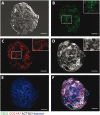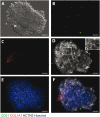Cardiac Non-myocyte Cells Show Enhanced Pharmacological Function Suggestive of Contractile Maturity in Stem Cell Derived Cardiomyocyte Microtissues
- PMID: 27125969
- PMCID: PMC4922542
- DOI: 10.1093/toxsci/kfw069
Cardiac Non-myocyte Cells Show Enhanced Pharmacological Function Suggestive of Contractile Maturity in Stem Cell Derived Cardiomyocyte Microtissues
Abstract
The immature phenotype of stem cell derived cardiomyocytes is a significant barrier to their use in translational medicine and pre-clinical in vitro drug toxicity and pharmacological analysis. Here we have assessed the contribution of non-myocyte cells on the contractile function of co-cultured human embryonic stem cell derived cardiomyocytes (hESC-CMs) in spheroid microtissue format. Microtissues were formed using a scaffold free 96-well cell suspension method from hESC-CM cultured alone (CM microtissues) or in combination with human primary cardiac microvascular endothelial cells and cardiac fibroblasts (CMEF microtissues). Contractility was characterized with fluorescence and video-based edge detection. CMEF microtissues displayed greater Ca(2+ )transient amplitudes, enhanced spontaneous contraction rate and remarkably enhanced contractile function in response to both positive and negative inotropic drugs, suggesting a more mature contractile phenotype than CM microtissues. In addition, for several drugs the enhanced contractile response was not apparent when endothelial cell or fibroblasts from a non-cardiac tissue were used as the ancillary cells. Further evidence of maturity for CMEF microtissues was shown with increased expression of genes that encode proteins critical in cardiac Ca(2+ )handling (S100A1), sarcomere assembly (telethonin/TCAP) and β-adrenergic receptor signalling. Our data shows that compared with single cell-type cardiomyocyte in vitro models, CMEF microtissues are superior at predicting the inotropic effects of drugs, demonstrating the critical contribution of cardiac non-myocyte cells in mediating functional cardiotoxicity.
Keywords: S100A1; cardiac microtissue; cardiotoxicity; contractility; hESC-CMs; inotropy.
© The Author 2016. Published by Oxford University Press on behalf of the Society of Toxicology.
Figures






References
-
- Abassi Y. A., Xi B., Li N., Ouyang W., Seiler A., Watzele M., Kettenhofen R., Bohlen H., Ehlich A., Kolossov E, et al. (2012). Dynamic monitoring of beating periodicity of stem cell-derived cardiomyocytes as a predictive tool for preclinical safety assessment. Br. J. Pharmacol. 165, 1424–1441. - PMC - PubMed
-
- Abi-Gerges N., Pointon A., Pullen G. F., Armstrong D., Valentin J. P., Pollard C. E., Morton M. J., Oldman K. L. (2013). Preservation of cardiomyocytes from the adult heart. J. Mol. Cell. Cardiol. 64, 108–119. - PubMed
-
- Aird W. C. (2007). Phenotypic heterogeneity of the endothelium: II. Representative vascular beds. Circ. Res. 100, 174–190. - PubMed
-
- Albanell J., Gascon P. (2005). Small molecules with EGFR-TK inhibitor activity. Curr. Drug Targets 6, 259–274. - PubMed
Publication types
MeSH terms
Substances
Grants and funding
LinkOut - more resources
Full Text Sources
Other Literature Sources
Miscellaneous

